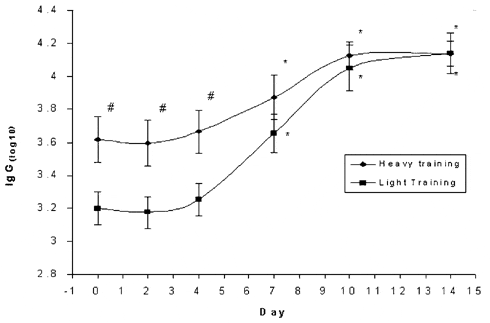In an attempt to explain the apparent increase in susceptibility to infection in well-trained individuals, investigators have made numerous in vitro measurements. However, the clinical significance of these observed changes is not clear. Therefore, to investigate the effect of exercise on the response of the intact immune system to a challenge in vivo we have measured the speed and overall immunoglobulin G (IgG) response to influenza vaccination in humans engaged in heavy and light training.
Following local ethical approval and informed written consent, 21 male subjects (age 22.5 ± 3.5 years; mean ± S.D.), of varying fitness (ΩO2,max 45.8 ± 13.9 ml kg-1 min-1) were recruited. Subjects suffering from influenza in the previous season were excluded from the study. Following initial determination of ΩO2,max on a cycle ergometer, all subjects carried out 1 week of their normal exercise routine, with training load measured using heart rate monitoring and subsequent calculation of training impulse (TRIMPS) (Banister et al. 1999). Subjects were then split into two groups based on their week 1 totals; ten subjects in the heavy training group were encouraged to at least maintain their activity levels (TRIMPS 512 ± 89) while the light training group continued as controls (TRIMPS 210 ± 90). Three weeks of monitored training were carried out, with all subjects vaccinated with influenza vaccine 1 week into this period. Venous blood samples were collected at 0, 2, 4, 7, 10 and 14 days post-vaccination. Serum IgG to three strains of influenza were determined by ELISA.
Results showed a significant difference in baseline IgG between groups (B/Yamanashi strain, P < 0.05, Mann-Whitney) but no difference between groups in the final IgG level post-vaccination (Fig. 1). The earliest significant increase in IgG occurred by day 7 in both groups (Fig. 1).
When training load was correlated with total fold IgG response, significant inverse relationships (Spearman’s) were found in two of the three influenza strains (B/Yamanashi r = -0.64 P < 0.01; A/Caledonian r = -0.57, P < 0.05). Significant inverse correlations were also found, however, between pre-vaccine IgG concentrations, and vaccine-induced fold IgG responses (B/Yamanashi r = -0.70, P < 0.01; A/Caledonian r = -0.74, P < 0.01; A/Panama r = -0.50, P < 0.05). Although training loads were significantly different between groups, individual time trial performance and overnight heart rate measurements were not suggestive of overtraining in the heavy training group.
The present data suggest that habitual physical activity may have an effect on baseline antibody concentrations, which in turn affects fold antibody responses to vaccination. The training loads carried out in this study had no effect on overall antibody concentrations 14 days post-vaccine.

